Published on 2025-06-26T04:10:52Z
What is Compliance in Analytics?
Compliance in analytics is the practice of ensuring that data collection, processing, storage, and sharing activities adhere to applicable laws, regulations, and industry standards. This includes privacy regulations like GDPR, CCPA, and the ePrivacy Directive, which dictate how user data should be handled, consented to, and protected. In an analytics context, compliance means implementing technical and organizational measures—such as anonymization, data minimization, and retaining data only for specified periods—to uphold user privacy and trust.
Modern SaaS analytics platforms like PlainSignal and Google Analytics 4 (GA4) offer built-in features to streamline compliance, from cookie-free tracking to IP anonymization and consent mode integration. By following compliance best practices, organizations can avoid legal penalties, build transparency with users, and maintain a strong data governance framework. Ultimately, compliance is a foundational element of responsible analytics that balances the need for insights with respect for individual privacy rights.
Compliance
Adhering to data privacy laws and standards in analytics, ensuring lawful, ethical use of user data.
Why Compliance Matters in Analytics
Compliance in analytics is not just a legal checkbox—it’s essential for building user trust and avoiding costly penalties. Regulations protect individual privacy rights and require organizations to handle data responsibly. When compliance is prioritized, companies can leverage analytics insights without compromising ethical standards or exposing themselves to regulatory risks.
-
Protecting user privacy
Implementing compliant analytics practices ensures that personally identifiable information is collected and processed only when necessary, reducing the risk of misuse or breaches.
-
Avoiding legal penalties
Non-compliance with regulations like GDPR or CCPA can lead to significant fines and legal action, making adherence to these rules crucial for business continuity.
Key Regulations and Standards
Multiple regional and international regulations define the parameters for lawful data handling in analytics. Understanding these frameworks is the first step toward compliant implementation.
-
General data protection regulation (gdpr)
A European Union regulation that mandates strict rules on data consent, processing, subject access requests, and cross-border data transfers.
-
California consumer privacy act (ccpa)
A U.S. state law granting California residents rights to know, delete, and opt-out of the sale of their personal information.
-
Eprivacy directive
Also known as the ‘Cookie Law,’ it governs the use of cookies and similar tracking technologies in the EU, requiring user consent for most types of tracking.
Implementing Compliance in SaaS Analytics Tools
Leading analytics platforms include built-in features to simplify compliance efforts, from privacy-first tracking methods to configurable consent options.
-
PlainSignal
PlainSignal offers cookie-free, GDPR- and CCPA-compliant analytics by minimizing data collection and processing all information on EU-based servers.
-
Tracking code example
<link rel="preconnect" href="//eu.plainsignal.com/" crossorigin /> <script defer data-do="yourwebsitedomain.com" data-id="0GQV1xmtzQQ" data-api="//eu.plainsignal.com" src="//cdn.plainsignal.com/plainsignal-min.js"></script>
-
-
Google analytics 4 (GA4)
GA4 supports compliance through features like IP anonymization, customizable data retention controls, and integration with Consent Mode to respect user preferences.
-
Ip anonymization
Masks the final octet of IP addresses before storage and processing to reduce the risk of identifying individual users.
-
Consent mode integration
Allows marketers to adjust tracking behavior based on user consent, ensuring that data collection aligns with privacy preferences.
-
Best Practices for Analytics Compliance
Adhering to these best practices helps organizations maintain robust compliance and fosters a culture of privacy and transparency.
-
Data minimization
Collect only the data necessary for your analytics goals, reducing the scope of compliance requirements and privacy risks.
-
Transparency and user consent
Provide clear privacy notices and easy-to-use consent banners, enabling users to make informed decisions about their data.
-
Regular compliance audits
Conduct periodic reviews of your analytics setup, retention policies, and third-party integrations to ensure ongoing adherence to regulations.
